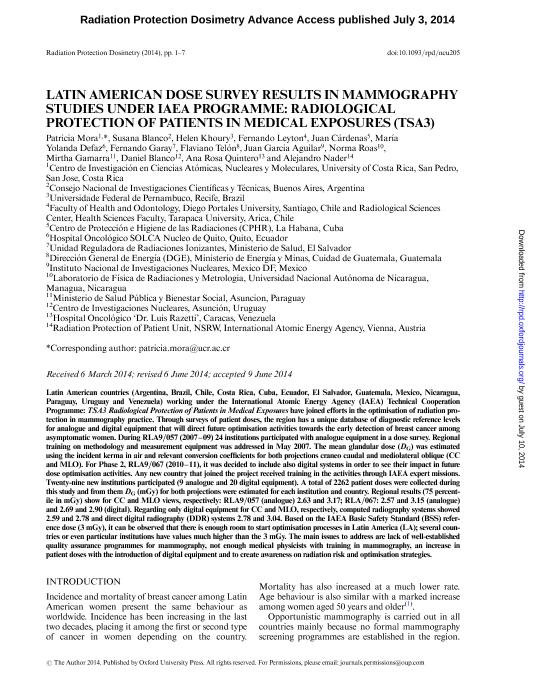Artículo
Latin American dose survey results in mammography studies under IAEA Programme: Radiological Protection of Patients in Medical Exposures (TSA3)
Mora, Patricia; Blanco, Susana Alicia Ana ; Khoury, Helen; Leyton, Fernando; Cárdenas, Juan; Defaz, María Yolanda; Escobar, Carolina; Flaviano Telón; García Aguilar, Juán; Roas, Norma; Gamarra, Mirta; Blanco, Daniel; Quintero, Ana Rosa; Nader, Alejandro
; Khoury, Helen; Leyton, Fernando; Cárdenas, Juan; Defaz, María Yolanda; Escobar, Carolina; Flaviano Telón; García Aguilar, Juán; Roas, Norma; Gamarra, Mirta; Blanco, Daniel; Quintero, Ana Rosa; Nader, Alejandro
 ; Khoury, Helen; Leyton, Fernando; Cárdenas, Juan; Defaz, María Yolanda; Escobar, Carolina; Flaviano Telón; García Aguilar, Juán; Roas, Norma; Gamarra, Mirta; Blanco, Daniel; Quintero, Ana Rosa; Nader, Alejandro
; Khoury, Helen; Leyton, Fernando; Cárdenas, Juan; Defaz, María Yolanda; Escobar, Carolina; Flaviano Telón; García Aguilar, Juán; Roas, Norma; Gamarra, Mirta; Blanco, Daniel; Quintero, Ana Rosa; Nader, Alejandro
Fecha de publicación:
06/2014
Editorial:
Oxford University Press
Revista:
Radiation Protection Dosimetry
ISSN:
0144-8420
Idioma:
Inglés
Tipo de recurso:
Artículo publicado
Clasificación temática:
Resumen
Latin American countries (Argentina, Brazil, Chile, Costa Rica, Cuba, Ecuador, El Salvador, Guatemala, Mexico, Nicaragua, Paraguay, Uruguay and Venezuela) working under International Atomic Energy Agency (IAEA) Technical Cooperation Programme: TSA3 Radiological Protection of Patients in Medical Exposures have joined efforts in the optimization of radiation protection in mammography practice. Through surveys of patient doses, the region has a unique database of diagnostic reference levels for analog and digital equipment that will direct future optimization activities, towards the early detection of breast cancer among asymptomatic women. During RLA9/057 (2007-2009) 24 institutions participated with analog equipment in a dose survey. Regional training on methodology and measurement equipment was addressed in May 2007. Mean glandular dose (DG) was estimated using the incident kerma in air and relevant conversion coefficients for both projections craneo caudal and mediolateral oblique (CC and MLO). For phase two, RLA9/067 (2010-2011), it was decided to include also digital systems in order to see their impact in future dose optimization activities. Any new country that joined the project received training in the activities through IAEA expert missions. 29 new institutions participated (9 analog and 20 digital equipment). A total of 2262 patient doses were collected during this study and from them DG (mGy) for both projections were estimated for each institution and country. Regional results (75 percentile in mGy) show for CC and MLO respectively: RLA9/057 (analog) 2.63 and 3.17; RLA/067: 2.57 and 3.15 (analog) and 2.69 and 2.90 (digital). Regarding only digital equipment for CC and MLO respectively, computed radiography (CR) systems showed 2.59 and 2.78 and direct digital radiography (DDR) systems 2.78 and 3.04. Based on the IAEA Basic Safety Standard (BSS) reference dose (3mGy), it can be observed that there is enough room to start optimization processes in Latin America (LA); several countries or even particular institutions have values much higher than the 3mGy. Main issues to address are: lack of well established Quality Assurance (QA) programs for mammography, not enough medical physicists with training in mammography, an increase in patient doses with the introduction of digital equipment and to create awareness on radiation risk and optimization strategies,
Palabras clave:
MAMMOGRAPHY
,
QUALITY CONTROL
,
MEAN GLANDULAR DOSE
,
LATIN AMERICAN
,
IAEA
Archivos asociados
Licencia
Identificadores
Colecciones
Articulos(SEDE CENTRAL)
Articulos de SEDE CENTRAL
Articulos de SEDE CENTRAL
Citación
Mora, Patricia; Blanco, Susana Alicia Ana; Khoury, Helen; Leyton, Fernando; Cárdenas, Juan; et al.; Latin American dose survey results in mammography studies under IAEA Programme: Radiological Protection of Patients in Medical Exposures (TSA3); Oxford University Press; Radiation Protection Dosimetry; 6-2014; 1-7
Compartir
Altmétricas



